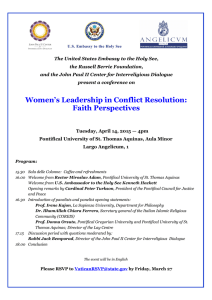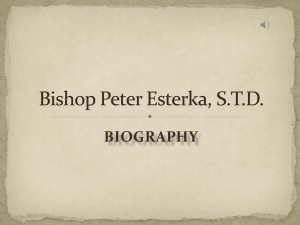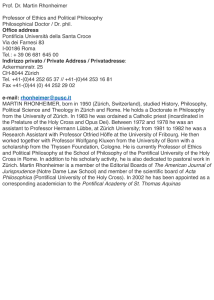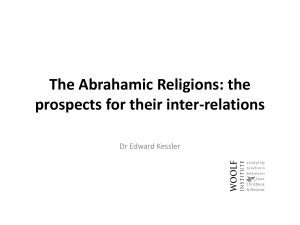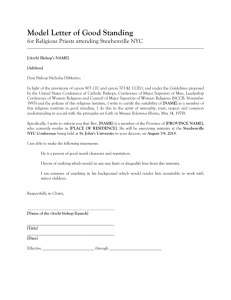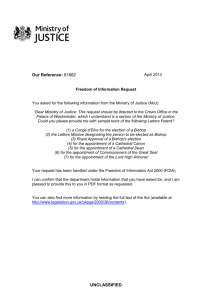Pre-print - Open Research Exeter (ORE)
advertisement
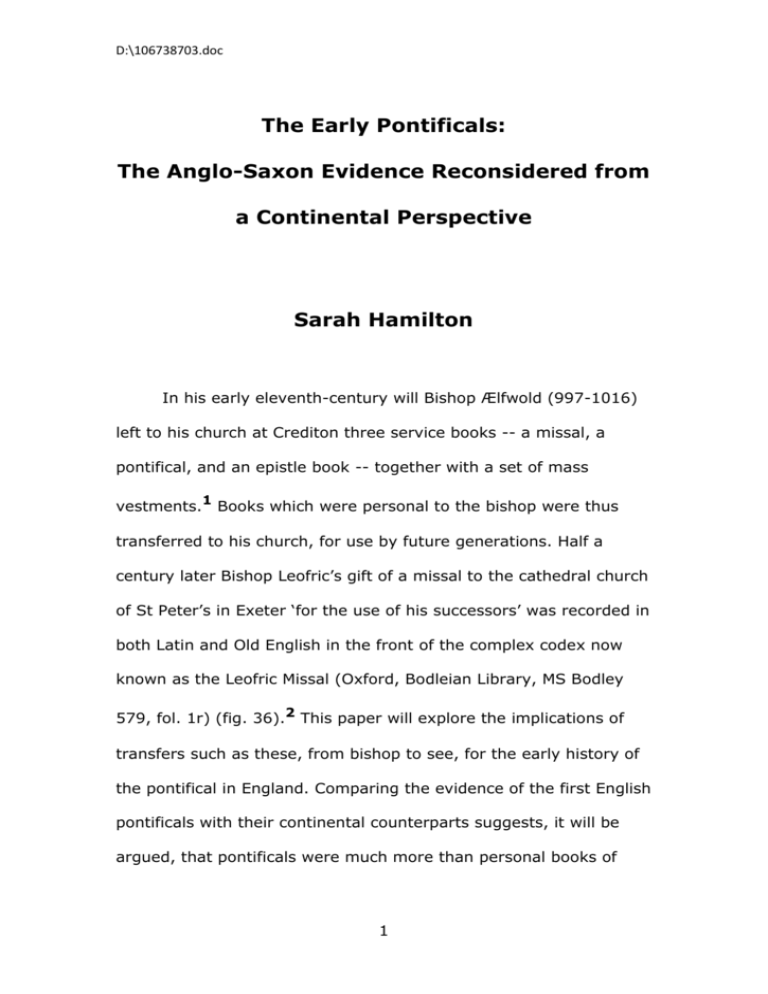
D:\106738703.doc The Early Pontificals: The Anglo-Saxon Evidence Reconsidered from a Continental Perspective Sarah Hamilton In his early eleventh-century will Bishop Ælfwold (997-1016) left to his church at Crediton three service books -- a missal, a pontifical, and an epistle book -- together with a set of mass vestments.1 Books which were personal to the bishop were thus transferred to his church, for use by future generations. Half a century later Bishop Leofric’s gift of a missal to the cathedral church of St Peter’s in Exeter ‘for the use of his successors’ was recorded in both Latin and Old English in the front of the complex codex now known as the Leofric Missal (Oxford, Bodleian Library, MS Bodley 579, fol. 1r) (fig. 36).2 This paper will explore the implications of transfers such as these, from bishop to see, for the early history of the pontifical in England. Comparing the evidence of the first English pontificals with their continental counterparts suggests, it will be argued, that pontificals were much more than personal books of 1 D:\106738703.doc liturgy used by the bishop in his ministry, and had several different purposes, reflecting their various users and owners. The pontifical, that is an ‘all-in-one’ codex of those noneucharistic rites reserved to the bishop, first emerged as a separate genre in the late ninth and tenth centuries.3 Such codices were far from homogenous but often combined rites for the dedication of churches and other sacred spaces with those for the ordination and consecration of the regular and secular clergy, the blessing of the chrism, ordines for holding synods, rites for public penance, and, at least sometimes, rites for excommunication and confirmation. They were also often, but by no means always, combined with sacramentaries, and, or, collections of episcopal blessings, known as benedictionals.4 The earliest examples of such books are Frankish and date from the later ninth century.5 More polished, and much fuller, is the Romano-German Pontifical, produced in Mainz c. 950 which was widely copied within the Reich,to which we return below.6 The oldest surviving Anglo-Saxon codex comes in the shape of the pontifical made for Archbishop Dunstan of Canterbury (959/60 – 988) at Christ Church Canterbury, probably c. 960,7 although there also survive two fragments which Helmut Gneuss has identified as belonging to one pontifical, the script of which has been dated on palaeographical grounds by David Dumville to c. 930.8 Some seven other more or less complete pontificals survive 2 D:\106738703.doc from the late tenth or first decades of the eleventh century, and some eighteen examples in all for the Anglo-Saxon Church.9 The evidence of the surviving Anglo-Saxon pontificals suggests they were produced within the context of the Anglo-Saxon Church’s tenth-century reform movement, itself a conscious extension of the ideals and texts of the ninth-century Frankish church reforms which, in emphasising episcopal ‘status and responsibilities’, had provided the context for the emergence of the first Frankish pontificals.10 Nicholas Orchard’s recent work has not only persuasively suggested evidence for at least two earlier Anglo-Saxon pontificals, but has also emphasised the strength of indigenous English rites. Thus he has identified at the heart of the Leofric Missal an updated eighthcentury Gelasian sacramentary-cum-pontifical probably made at Canterbury for the early tenth-century reforming archbishop, Plegmund, (890-914), to which various prayers, blessings, chants, collects and masses were added over the course of the tenth century at Canterbury, under archbishops Wulfhelm, Oda, and Dunstan; finally, further texts were added in the mid-eleventh century at Exeter, under another reformer, Bishop Leofric.11 The second ‘earlier’ English pontifical underlies the pontifical-cumsacramentary now known at the Sacramentary of Ratoldus (Paris, Bibliothèque nationale, Ms lat. 12052).12 Copied in northern France in the second half of the tenth century, on the orders of Ratoldus, 3 D:\106738703.doc abbot of Corbie (972-86), it combines the text of a ninth-century sacramentary originally from Saint-Denis via Orléans and then Saint-Vaast with that of a now-lost pontifical from mid-tenthcentury Canterbury.13 Orchard’s work thus brings the chronology for the development of the pontifical in England closer to that for Frankia, suggesting that pontificals can be found as far back as around 900. At the same time, his stress on the continuing independence of the English from the Frankish liturgy means that Anglo-Saxon pontificals can no longer be viewed as a simple extension of the Frankish ninth-century reforms.14 Current explanations for the emergence of the pontifical in both Frankia and England thus favour two interpretations. First, the dissemination of pontificals in both England and East Frankia is seen as being led by the archiepiscopal sees as part of an effort to stamp their authority over other sees; pontificals are thus indelibly linked with efforts at royally-supported ecclesiastical reform movements which emphasised the role and duties of bishops. David Dumville’s stimulating study of the palaeography of the Anglo-Saxon pontificals suggests that a new one was produced at Christ Church, Canterbury for each new archbishop, and on the death of the archbishop, that of the previous archbishop was disseminated to another diocese on the occasion of the consecration of a new bishop to a see.15 Yet some pontificals, as he acknowledges, were written at other sees.16 4 D:\106738703.doc Éric Palazzo has suggested that underlying the appearance of the pontifical in Frankia is the increasing emphasis from the ninth century onwards on the authority of the bishop in his diocese, which was manifest in the liturgy of the church as well as other texts such as the Carolingian bishops’ capitula, penitentials and canon law collections, and also artistic depictions of bishops.17 The continental pontifical thus reflects the political importance placed on bishops by later ninth-century and tenth-century rulers, especially Ottonian ones. In the Reich the ‘primitive pontificals’ were first codified in the mid-tenth-century into a large and comprehensive, if somewhat fluid collection, now known as the Romano-German Pontifical , which combines liturgical rites with didatic texts, including liturgical exposition.18 Cyrille Vogel and Reinhard Elze traced the pontifical’s origins to the monastery of St Alban in Mainz in the mid-tenth century, and the pontificate of Archbishop William of Mainz, the son and chancellor of Otto I, arguing that its diffusion was part of a conscious plan by the Ottonian rulers to promote a unified episcopal liturgy.19 The Romano-German Pontifical was thus viewed as an essential component of the ‘imperial church system’, shoring up and promoting episcopal authority under the command of German rulers. Whilst this explanation is very much of its time – Vogel and Elze were working in the 1950s – it was still being used as recently as 2000.20 Tim Reuter’s critique of the ‘imperial church system’, 5 D:\106738703.doc now almost thirty years old, has seemingly not yet been integrated into liturgists’ thinking: yet Reuter’s argument, that episcopal appointment and by implication authority, owed at least as much to local power structures as royal authority, helps explain some of the more localised features of the tenth- and eleventh-century pontifical evidence.21 A further nail in the coffin for bland acceptance of the imperial promotion thesis is research on the ninth century which has shown that the Carolingian liturgical reforms were not as intentional, nor as uniform, nor as successful, as previously thought: the Carolingian ecclesiastical and secular rulers did not seek to impose the single Romanised liturgy of the Hadrianum Sacramentary throughout the Frankish kingdoms. By the death of Charles the Bald the Frankish liturgy was by no means unified, although there was common agreement about general forms.22 Why should the Ottonian or Anglo-Saxon experiences therefore have been any different? The second explanation views the pontifical as essentially a practical book which emerged to support the bishop in his work. Niels Rasmussen’s researches on the primitive pontificals suggest that this new genre emerged as a response to practical need as itinerant bishops sought to combine records of the rite for noneucharistic services, the ordines, previously recorded in libelli, into one volume. In the mid 1970s he demonstrated that there was no 6 D:\106738703.doc rhyme nor reason as to which rites were copied, but that the ones most commonly copied seem to have been those which an itinerant bishop would require on tours of his diocese: those for church dedications, the ordination of secular clergy, the consecration of regular clergy, and the administration of public penance.23 Rasmussen’s work was based on a study of the codicology, and emphasised practical considerations, such as the size of the book: a small codex such as that of the Leofric Missal (now 195 mm high by 145 mm wide) was more likely to be carried around the diocese by the bishop.24 Larger manuscripts, on the other hand, may have been intended as cathedral models, that is as authoritative records of liturgical rites, which were copied into libelli for actual use, and as records of liturgical exposition and other quasi-liturgical texts for teaching and reflection, as in hybrid collections such as the Romano-German Pontifical.25 The benedictionals and pontificals of the late Anglo-Saxon episcopate have also been examined as pragmatic texts by Richard Pfaff, and found wanting. Whilst pontifical texts do reflect practical concerns – rubrics specify the modulation in tone, for example, of an antiphon, as in one mideleventh-century Canterbury pontifical, – as codices they were often not user friendly.26 The lack of tabula in many codices, combined with the very diversity of their content, means it would be difficult for the uninitiated to find their way around the book easily. He has 7 D:\106738703.doc thus raised problems for those who want to see them as wholly pragmatic texts, and therefore poses a challenge to this explanation as to why pontificals emerge. It is not the intention of this paper to unravel either of the two strands which make up the current consensus about the pontifical’s early history, but rather to point out that because they are both, naturally, based on the collections of rites which lay at the core of each pontifical, they neglect the evidence of the many liturgical, and non-liturgical, texts added to, or sometimes copied with, this central corps of rites in many codices. Such additions have not been entirely ignored: they are often mined by scholars to locate a particular codex in space and time,27 whilst David Dumville has examined documents added to liturgical books as a specific category.28 At the same time, scholars have tended to emphasise pontificals as personal to the bishop, either as the propagator of, or recipient of, reform.29 They thus fail to take into account the implications of the seemingly frequent movement of pontifical from bishop to cathedral community, and its continued use within that community, with which this paper began. In what follows I highlight four characteristics of the surviving pontifical tradition in England and the Continent which require consideration by those looking to explain why the pontifical emerged when it did: 8 D:\106738703.doc (1) the significance of the inclusion of local traditions in reform-orientated collections of rites (2) the function of these codices as didactic texts (3) the role of pontificals as repositories of local record (4) the importance of pontifical books as both personal artefacts and as the focus for the memory of a particular bishop, and sometimes his successors, in a particular see. To start with the first point, the continuing importance of local traditions, it is widely recognised that the very act of copying led to a good deal of variation; it is, however, also worth stressing that pontificals were often self-conscious compilations of texts which combined new, imported texts, with more indigenous traditions.30 In the English material, this pattern can be seen in the early eleventh-century pontifical, now known as the ‘Samson Pontifical’ (Cambridge, Corpus Christi College, MS 146), to which a supplement was added in the late eleventh century.31 David Dumville suggests, on palaeographical grounds, that the ‘original part’ was written at Canterbury. Neil Ker had, however, noticed various Winchester-elements in the liturgy of the ‘original part’. Dumville reconciles these two observations by suggesting that the manuscript was made for Archbishop Ælfheah of Canterbury (10061012) who had formerly been bishop of Winchester.32 Similarly, 9 D:\106738703.doc Michael Lapidge has demonstrated that the quire added in England to a German copy of the Romano-German Pontifical corresponds with what is known of Archbishop Ealdred of York’s life, and thus that the Pontifical was probably bought back to England by the archbishop after his visit to Cologne in 1054; the addition of a sermon on the office for the dead, and the text of the office itself, for example, fit with a later tradition that Ealdred exhorted his clergy to remember the dead.33 That such additions were common is clear from two continental manuscripts: one mid-eleventh-century Burgundian codex, 34 from the archiepiscopal see of Besançon, is essentially a copy of the Romano-German Pontifical , but includes a sort of supplement, made at the same time as the main part, on its first thirty-eight folios of a series of rites not found in the second part,35 all of which can be localised to Besançon through their mention of the church and its saints; the supplement includes rites for episcopal ordination, the consecration of an abbess, an abbot, a nun, and a widow, and a nun, a blessing for a knight, the consecration of a church, the altar and the vestments, coronation ordines for both king and queen, and a set of (mostly) temporal episcopal benedictions. These rites are all central to the bishop’s authority within his diocese; perhaps this is why Archbishop Hugues de Salins, (1031-66) chose to have them copied into this codex. An 10 D:\106738703.doc early eleventh-century pontifical, which was in Cambrai by the late eleventh century, reveals a more complex tale of the weaving of new and indigenous texts. Most of its ordines are drawn from the Romano-German Pontifical , but it includes a rite for the reconciliation of penitents on Maundy Thursday found only in Lotharingia and north-eastern France.36 Hartmut Hoffman has identified the manuscript as the work of four scribes, three of whom were from Mainz, and one from Metz; the Lotharingian scribe was the one who copied the Lotharingian rite for the reconciliation of penitents, suggesting that whoever commissioned the book was anxious to include some of their own rites to which they attached importance, as well as acquire an up-to-date liturgy.37 Secondly, as has been widely recognised, pontificals also acted as repositories for didactic texts, perhaps most famously the expositiones missae.38 For example, the Dunstan, Egbert and Lanalet Pontificals all include a copy of Gerbald of Liège’s early ninth-century episcopal capitulary, prefaced by the prologue of a penitential attributed to Egbert archbishop of York, together with an Anglo-Saxon version of the text ‘De officiis VII graduum’.39 These capitula deal with a priest’s duties in simple terms: they include the injunction that he should say the office, preach on feast days and Sundays, collect the tithe, teach the people the creed and the Lord’s prayer, not receive payment for baptism, not eat nor drink in 11 D:\106738703.doc taverns.40 The inclusion of such a text suggests these codices were cathedral books, used to educate the clergy, rather than being used by the bishop to administer particular rites. A similarly educative purpose may lie behind the Old English translation of Amalarius’s liturgical exposition on the spiritual significance of church bells included at the front of the mid-eleventh-century pontifical from Canterbury, now Cambridge, Corpus Christi College, MS 44.41 The use of the first person in a rubric about sprinkling hot water only once in the ordo for the dedication of a church in the Dunstan Pontifical, is also suggestive of a didactic purpose; it is at least possible that the text might have been used for instruction in the training of priests.42 Distinguishing between texts which are primarily didactic, and those which have a more pragmatic purpose, is, however, often impossible. What should we make of the various texts added at Sherborne to a copy of the Romano-German Pontifical , London, British Library, Ms Cotton Tiberius C.i, in the late eleventh century which include Old English confession formulae, prayers, and Lenten homilies?43 The practical nature of some additions is seemingly clearer cut: an eleventh-century pontifical, now in Montpellier, made for Archbishop Hugues of Besançon, includes an oath of continence to be sworn by priests in the presence of the archbishop, added in a slightly later, ‘maladroit’ hand, which has been linked to the canons of the Council of Bourges 12 D:\106738703.doc (1031) which required priests to promise celibacy.44 Its inclusion testifies to the liveliness of the pontifical as a text but its unprofessional presentation might suggest that this oath was included as a matter of record rather than for administration as part of the liturgy. The Besançon oath may therefore anticipate the third category of additions, those which suggest that the pontificals were used, as gospel books also often were, as repositories of local record.45 The Leofric Missal includes the texts of several manumissions from the late eleventh century.46 The Dunstan Pontifical includes the records of a synod and seeming form letters announcing the death of a monk and letters of penance.47 The early tenth-century Sens Pontifical includes written in the margins and on blank parts of folios throughout the manuscript in various tenth- and eleventh-century hands the texts of oaths of fidelity of twenty-seven suffragan bishops of the province of Sens.48 The rationale for the inclusion at the beginning of Claudius Pontifical I, the pontifical with additions in Archbishop Wulfstan’s handwriting, of a text, in both Latin and Old English, of the lawcode known as VI Æthelred, is less clear.49 As Patrick Wormald suggested, its presence may be more about demonstrating respect for the law by 13 D:\106738703.doc including it in a holy book rather than testimony of an educative or bibliographic purpose.50 Turning to the fourth observation, that pontificals often function as both personal and ‘institutional’ storehouses of memory, it has been widely recognised that particular pontificals were made for particular bishops.51 Both the rite for the consecration of a bishop and the litany in an eleventh-century pontifical from the diocese of Verden (Bamberg, Staatsbibliothek, MS Lit. 59) mentions Bishop Bruno by name, for example.52 The Lanalet Pontifical includes the addition, in Old English, that ‘Bishop Lyfinc owns this book’. This was most probably Leofric’s predecessor, Bishop Lyfing of Crediton and Cornwall, and later Worcester (1027-46), although Lyfing, the early tenth-century bishop of Wells (998/9-1013) has also been suggested; clearly whichever bishop it was, the book was viewed as a personal object.53 There is nothing about ownership as clear cut amongst the other English pontificals (except for the Leofric Missal), although other related types of books, such as the benedictional made for Bishop Æthelwold, are witness to such personal ownership.54 Yet the personal nature of such books had later resonances for the cathedral communities which preserved them. Perhaps the best example of a personal pontifical is that commissioned by 14 D:\106738703.doc Bishop Gundekar of Eichstätt (1057-75) in the last years of his pontificate c. 1072-5.55 This includes the remarkable autobiographical text in which Gundekar records the circumstances in which as a court chaplain to the empress Agnes, mother and regent for Henry IV, he was designated bishop in the imperial palace at Tribur on 20 August 1057, invested at Speyer on 5 October, and enthroned at Eichstätt on 17 October.56 This text has a link to the pontifical’s liturgical contents: for this pontifical included, as many did, a ‘mass for the bishop on the anniversary of his ordination’, and two masses to be said by the priest in the bishop’s absence.57 All three mass texts can be found as far back as the eighth-century Gelasian sacramentaries, but circulated widely in the Romano-German Pontifical.58 A similar mass to be said for the bishop was added to the Leofric Missal at Exeter under Leofric, possibly in Leofric’s own writing,59 and another to be said by the bishop of Exeter on (the anniversary of) his ordination, possibly composed by Leofric himself.60 Such masses mark the fact that such books were personal to their owners but also act as hooks for their own, and their clergy’s memories of important events in the see’s history. The calendar in the Gundekar codex records in the main hand the obits of the bishop’s father,mother and sister, and the investiture and ordination of the bishop himself; a later hand added Gundekar’s own obit.61 But Gundekar also commissioned a 15 D:\106738703.doc set of portraits of all the bishops of his see to date, beginning with its founder, the Anglo-Saxon missionary Willibald, and culminating with a portrait of himself (fig. 37).62 These portraits, together with prayers in which Gundekar petitioned prayers for both himself and his predecessors, and the inclusion of a list of previous bishops, thus linked Gundekar to the institutional history of his church.63 The pontifical also included a record of all the altars and churches Gundekar had consecrated during his pontificate, spreading out from his cathedral church to encompass the wider diocesan community.64 A century after Gundekar’s death this pontifical metamorphosed into a vehicle for recording the history of the diocese: from the end of the twelfth century the portraits of his successors, many with vitae, were added, concluding with the sixteenth-century bishop Gabriel von Eyb (1496-1535).65 Gondekar’s pontifical helps explain the additions made to both the Dunstan Pontifical and the Leofric Missal. The ‘Dunstan Pontifical’ is attributed to Archbishop Dunstan because of the inclusion, in the original hand of the principal scribe of the text, of a letter from Pope John XII to Dunstan granting him the pallium as archbishop of Canterbury in 960.66 Later in the century it was at Sherborne, however, for other hands, added a letter from the archbishop of Canterbury to Bishop Wulfsige of Sherborne (9931001),67 two formulae letters on penance,68 a letter by Bishop 16 D:\106738703.doc Æthelric of Sherborne (1002-9),69 a list of the bishops of Sherborne up to Ethelric, bishop in 1001,70 as well as various benedictions,71 a record of the religious practices agreed by a synod of bishops to be undertaken on notification of the death of a fellow bishop, part of a mass for the dead, and a letter announcing the death of a monk,72 and two sermons in Old English on the dedication of a church.73 The benedictions and, perhaps, the sermons in Old English looks very much like pragmatic additions, along the lines of the excommunication formula added a century later when the manuscript had moved to Normandy74: the sort of text used on a one off occasion, and added for the record to such a manuscript. The letter from Pope John XII to Dunstan granting him the pallium was added in the hand of the scribe who wrote the main part of the manuscript: it was as personal a text as Gundekar’s account of his election and consecration. Once the pontifical had passed to Sherborne, however, it soon became a book associated with the see, rather than an individual, as the list of bishops of Sherborne testifies. In mid-eleventh-century Exeter amongst the various additions made to the ‘Leofric Missal’ by scribes working in the Exeter scriptorium under Leofric, are a series of texts which, as Patrick Conner recognised, amount to a narrative history of the see and Leofric’s pontificate.75 Two scribes writing on the blank folios of a 17 D:\106738703.doc quire already added to the codex in Leofric’s scriptorium recorded a series of texts beginning with a letter supposedly sent by Pope Formosus to Edward the Elder on the division of the see of Sherborne in 909, a text which gave legitimacy to Crediton’s lordship over estates in Cornwall, and an account of Leofric’s appointment to the see, by one scribe.76 A second scribe added an account of Leofric’s request to Pope Leo IX to write to King Edward asking that the see be moved to Exeter; the text of the letter of Pope Leo IX; an account of how King Edward gave the monasterium of St Mary and St Peter in Exeter to Leofric, and how he was installed as bishop there by the king and queen; a text praising Leofric’s work in Exeter, especially his restoration of the see’s lands; and an obit note (fig. 38), of Leofric’s death and burial, and a request for the reader’s prayers.77 Leofric took over an existing codex, rather than commissioning one to be copied, as Gundekar did, but had revisions made to it; it was thus a personal book for the bishop, and, after his gift of the book to the cathedral became a book belonging to the institution. Pontificals were not merely pragmatic texts: they had multiple uses, a reflection of their different users. Their contents reflected the interests and identities of both bishops and their cathedral communities. It is important therefore to see them not just as practical guides, nor as solely didactic texts, but also as repositories 18 D:\106738703.doc for institutional memories: they display episcopal authority but they also embody episcopal memory. Nor were they merely bishop’s books: they often passed to, and were used by, the clergy. Stephanie Coué has demonstrated how clerical communities of German cathedrals commissioned and wrote episcopal vitae of previous bishops in order to negotiate with incoming bishops about the practices and identity of their see; cathedral-owned pontificals perhaps fulfilled a similar function but that is a matter for a different paper.78 19 D:\106738703.doc NOTES 1 ‘7 into Crydiantune þreo þeningboc, mæsseboc. 7 bletsungboc 7 pistelboc an mæssereaf’: Councils and Synods, I, 385. Helmut Gneuss has demonstrated that there was no clear distinction between benedictional and pontifical in Old English, and that the word ‘bletsungboc’ was used to refer to a combined pontifical-benedictional in the list of books Leofric left to Exeter cathedral: ‘Liturgical Books in Anglo-Saxon England and their Old English Terminology’, in Learning and Literature in Anglo-Saxon England: Studies Presented to Peter Clemoes on the Occasion of his Sixty-fifth Birthday, ed. by Michael Lapidge and Helmut Gneuss (Cambridge: CUP, 1985), pp. 91-141 (at pp. 131-33). 2 ‘Hunc missalem LEOFRICUS episcopus dat ęcclesię sancti petri apostolic in exonia ad utilitatem successorum suorum’: The Leofric Missal, ed. by Nicholas Orchard, HBS, 113-14, 2 vols (London: Boydell, 2002), II, 1 (fol. 1r). This work was one of 66 books Leofric left to his cathedral on his death; his bequest was recorded in Oxford, Bodleian Library, MS Auct. D. 2.16, fols 1r-2v, and Exeter, Cathedral Library, MS 3501, fols 1r-2v, and edited most recently by Michael Lapidge, ‘Surviving Booklists from Anglo-Saxon 20 D:\106738703.doc England’, in Learning and Literature in Anglo-Saxon England, ed. by Lapidge and Gneuss, pp. 33-89 at pp. 64-69. 3 The word itself is early modern: Glossarium Mediae et Infimae Latinitatis, ed. by Charles du Fresne, Seigneur du Cange, rev. by D. P. Carpenterius and others, 10 vols (Niort: L. Favre, 1886), VI, 408. 4 For a concise history, see Éric Palazzo, A History of Liturgical Books from the Beginning to the Thirteenth Century, trans. by M. Beaumont (Collegeville, MN: Liturgical Press, 1998), pp. 195-212; the most comprehensive work is that of Rasmussen, Pontificaux. 5 For example, the ‘Poitiers’ pontifical, probably composed for a late ninth-century archbishop of Bourges: Il cosidetto pontificale di Poitiers (Paris, Bibliothèque de l’Arsenal, cod. 227), ed. by Aldo Martini, Rerum ecclesiasticarum documenta, series major fontes 14 (Rome: Herder, 1979); the Sens pontifical, St Petersburg, Russian National Library, MS Q.v.I.no. 35, and the Beauvais pontifical, Leiden, University Library, Codices Bibliothecae Publicae Latini 111:2, both described in Rasmussen, Pontificaux, pp. 89-166. 6 Le pontifical romano-germanique du dixième siècle, ed. by C. Vogel and R. Elze, Studi e testi, 226-27 and 269, 3 vols (Vatican City: Biblioteca Apostolica Vaticana, 1963-72). It survives in some 21 D:\106738703.doc twenty-nine manuscripts from the later tenth and eleventh centuries: Sarah Hamilton, The Practice of Penance, 900–1050 (Woodbridge: Boydell, 2001), pp. 131-35 and 211-23. 7 Paris, BnF, MS lat. 943, described by V. Leroquais, Les pontificaux manuscrits des bibliothèques publiques de France, 4 vols (Paris: A. Villien, 1937), II, 6-10; Rasmussen, Pontificaux, pp. 258317; also important are Jane Rosenthal, ‘The Pontifical of St Dunstan’, in Dunstan LTC, pp. 143-63; on date, see David Dumville, Liturgy and the Ecclesiastical History of Late Anglo-Saxon England, Studies in Anglo-Saxon History, 5 (Woodbridge: Boydell, 1992), pp. 82-84. 8 Cambridge, Trinity College, MS B.1.30A, and New Haven, Yale University Library, MS 320; Gneuss, ‘Liturgical Books’, p. 132; David Dumville, ‘On the Dating of Some Late Anglo-Saxon Liturgical Manuscripts’, Transactions of the Cambridge Bibliographical Society, 10 (1991), 40-57 (at pp. 42-43). 9 ‘Egbert Pontifical’, Paris, BnF, MS lat. 10575 (c. 1000); ‘Claudius I’, London, BL, MS Cotton Claudius A.III, fols 31v-86v, 106r-50v (c. 1000, London/York); ‘Lanalet Pontifical’, Rouen, Bibliothèque municipale, MS 368 (A.27) (s.xiin, St Germans/Wells); ‘Anderson Pontifical’, London, BL, MS Add. 57337 (c. 1000, Christ Church, Canterbury); ‘Benedictional of Archbishop Robert’, Rouen, 22 D:\106738703.doc Bibliothèque municipale, MS 369 (Y.7) (c. 980 x 1020, New Minster Winchester); ‘Samson Pontifical’, Cambridge, Corpus Christi College, MS 146 (s. xex, Old Minster, Winchester/Canterbury); Cambridge, Sidney Sussex College, MS 100 (Δ.5.15), part 2 (s. xex/s.xiin, Ramsey Abbey/Winchester). Dumville, Liturgy, pp. 66-95, and critique in Janet L. Nelson and Richard W. Pfaff, ‘Pontificals and Benedictionals’, The Liturgical Books of Anglo-Saxon England, ed. by Richard W. Pfaff, Old English Newsletter Subsidia, 23 (Kalamazoo, MI: Medieval Institute Publications, 1995), pp. 87-98. 10 Nelson and Pfaff, ‘Pontificals and Benedictionals’, p. 87. 11 Leofric Missal, ed. by Orchard, I, pp. 1-234 (at pp. 131-32, 203-05, and 234). Plegmund played a significant part in the Alfredian reform, including advising on the translation of Gregory the Great’s Cura Pastoralis into English, and the evidence of minuscule script and improved Latinity in the Canterbury charters testify to his introduction of these reforms into the Canterbury scriptorium: Nicholas Brooks, The Early History of the Church of Canterbury: Christ Church from 597-1066 (Leicester: Leicester University Press, 1984), pp. 152-54, 173-74, and 213-14. On Leofric’s pastoral interests see Elaine M. Treharne, ‘Producing a Library in Late Anglo-Saxon England: Exeter, 1050-1072’, The Review of English Studies, new series 54 (2003), 155-72. 23 D:\106738703.doc 12 The Sacramentary of Ratoldus (Paris, Bibliothèque nationale de France, lat. 12052), ed. by Nicholas Orchard, HBS, 116 (London: Boydell, 2005). 13 Ratoldus, ed. by Orchard, pp. cxci-cxciii. 14 Cf. Dumville, Liturgy, p. 145: ‘it should not be too adventurous to suppose that in this first period of renewal there was heavy dependence on imported liturgical books.’ 15 Dumville, Liturgy, pp. 91-95. 16 See the critique by Nelson and Pfaff, ‘Pontificals and Benedictionals’. 17 Éric Palazzo, ‘La liturgie de l’Occident médiéval autour de l’an mil: État de la question’, Cahiers de civilisation médiéval, 43 (2000), 371-94; see also his Liturgical Books, p. 199, and his L’évêque et son image. L’illustration du pontifical au Moyen Âge (Turnhout: Brepols, 1999), pp. 17-35. The best English example of a book which emphasised the bishop’s authority is London, BL, MS Additional 49598: Robert Deshman, The Benedictional of Æthelwold, Studies in Manuscript Illumintation, 9 (Princeton, NJ: Princeton University Press, 1995). 18 Pontifical romano-germanique, ed. by Vogel and Elze. 24 D:\106738703.doc 19 M. Andrieu, Les Ordines romani du haut moyen âge, 5 vols (Louvain: Spicilegium Sacrum Lovaniense, 1931-61), I, 507-09; C. Vogel, ‘Le Pontifical romano-germanique du Xe siècle: nature, date et importance du document’, Cahiers de civilisation médiéval, 6 (1963), 27-48, and his Medieval Liturgy: An Introduction to the Sources, trans. and rev. by W. Storey and N. K. Rasmussen with J. K. Brooks-Leonard (Washington, DC: Pastoral Press, 1986), pp. 235-36. 20 Palazzo,‘La liturgie’, 379-82 . 21 ‘The “Imperial Church System” of the Ottonian and Salian Rulers: A Reconsideration’, Journal of Ecclesiastical History, 33 (1982), 347-74. 22 Yitzhak Hen, The Royal Patronage of Liturgy in Frankish Gaul to the Death of Charles the Bald (877), HBS, Subsidia, 3 (London: Boydell, 2001). 23 Rasmussen, Pontificaux; ‘Célébration épiscopale et célébration presbyteriale: Une essai de typologie’, in Segni e riti nella chiesa altomedievale occidentale: 11-17 aprile 1985, Settimane, 33 (Spoleto: La sede del Centro, 1987), pp. 581-603; ‘Unité et diversité des Pontificaux latins aux VIIIe, IXe et Xe siècles’, in Liturgie de l’église particulière et liturgie de l’Église universelle, 25 D:\106738703.doc Bibliotheca Ephemerides liturgicae subsidia, 7 (Rome: Edizioni Liturgiche, 1976), pp. 393-410. 24 S. J. P. Van Dijk and J. Hazelden Walker, The Origins of the Modern Roman Liturgy (Winchester, MD: Darton, Longman and Todd, 1960), p. 32, suggested a height of 20 cm as the boundary between portable and non-portable books. 25 Rasmussen, Pontificaux, pp. 479-80; Christopher A. Jones, ‘The Book of the Liturgy in Anglo-Saxon England’, Speculum, 73 (1998), 659-702 (at p. 698). 26 Citing Cambridge, Corpus Christi College, MS 44, ‘The Anglo-Saxon Bishop and his Book’, Bulletin of the John Rylands University Library of Manchester, 81 (1999), 3-24 (at p. 14). 27 E.g. Michael Lapidge’s examination of the quire added in England to a German copy of the Romano-German pontifical: ‘Ealdred of York and MS Cotton Vitellius E.XII’, Yorkshire Archaeological Journal, 55 (1983), 11-25. 28 Dumville, Liturgy, pp. 123-27. 29 Although the varied users of pontificals are noted by Pfaff, ‘The Bishop’s Book’, and implicit in Rasmussen’s recognition of some pontificals as ‘cathedral copies’. 26 D:\106738703.doc 30 See Orchard’s comments: Leofric Missal, ed. by Orchard I, 31 M. R. James, A Descriptive Catalogue of the Manuscripts in 117. the Library of Corpus Christi College, Cambridge, 2 vols (Cambridge: CUP, 1909-12), I, 332-35; N. R. Ker, Catalogue of Manuscripts Containing Anglo-Saxon, 2nd edn (Oxford: Clarendon, 1990), pp. 50-51. 32 Dumville, Liturgy, pp. 72-73 and 92-93. 33 Lapidge, ‘Ealdred of York’, p. 19. 34 Wolfenbüttel, Herzog August Bibliothek, MS lat. 4099 (Weissenburg. 15), fols 1-89; for a detailed description, see Andrieu, Ordines Romani, I, 441-52; for a more recent analysis which places this manuscript in the context of others produced for Archbishop Hugues de Salins, see B. de Vregille, Hugues de Salins, archevèque de Besançons, 1031-66 (Besançon: Cetre, 1981), pp. 341-44. 35 With one exception: the rite for the consecration of a widow is found in both parts: Andrieu, Ordines Romani, I, 445 and 447. 36 Paris, BnF, MS lat. 13313, fols 43v-50v. 27 D:\106738703.doc 37 H. Hoffmann, Buchkunst und Königtum im ottonischen und frühsalischen Reich, Schriften der MGH, 30 (Stuttgart: Hiersemann, 1986), p. 254; Hamilton, Practice, p. 161. 38 André Wilmart, ‘Expositio missae’, Dictionnaire d’archéologie chrétienne et de liturgie, ed. by F. Cabrol and others, 15 vols (Paris: Letouzey, 1903-53), V.i (1922), 1014-27; Roger E. Reynolds, ‘Liturgy, Treatises on’, Dictionary of the Middle Ages, ed. by Joseph R. Strayer and others, 13 vols (New York: Scribner, 1982-89), VII, 624-33. On liturgical exposition in England, see Jones, ‘Book of the Liturgy’. 39 Paris, BnF, MS lat. 943, fols 149r-150v; Rouen, Bibliothèque municipale, MS 368 (A.27), fols 178v-80v; Paris, BnF, MS lat. 10575, fols 6v-9r. For this observation see Ratoldus, ed. by Orchard, p. xcix. Roger E. Reynolds, ‘The “De officiis VIII graduum”: Its Origins and Early Medieval Development’, Medieval Studies, 34 (1972), 113-51. Gaerbald circulated more widely in tenth- and eleventh-century England: Capitula Episcoporum Pars I, ed. by P. Brommer, MGH Capit. Episc. 1 (Hanover: Hahn, 1984), pp. 6-16. 40 Capitula Episcoporum Pars I, ed. by Brommer, pp.16-21. 41 Ker, Catalogue, p. 46; Dumville, Liturgy, p. 71. 28 D:\106738703.doc 42 ‘Ter dixi intrinsecus propter imbuendam fidem trinitatis quam fatetur ecclesia, et semel extrinsecus propter unum: et non iteratum baptisma quod gerit exterius ecclesia’: De Antiquis Ecclesiae Ritibus Libri, ed. by Edmond Martène, 2nd edn, 4 vols (Antwerp: JohannesBaptistae de la Bry, 1736), II, Bk I, cap. viii, art.xi, ordo iii; Helen Gittos ‘Introduction’, The Liturgy of the Late Anglo-Saxon Church, ed. by Helen Gittos and M. Bradford Bedingfield, HBS, Subsidia, 5 (London: Boydell, 2005), pp. 1-12 (at p. 6). 43 N. R. Ker, ‘Three Old English Texts in a Salisbury Pontifical, Cotton Tiberius C.I’, The Anglo-Saxons: Studies in Some Aspects of their History and Culture Presented to Bruce Dickins, ed. by Peter Clemoes (London: Bowes and Bowes, 1959), pp. 262-79. Other additions in Latin include texts for making and consecrating the chrism, prayers to the holy cross on Good Friday, on the seven grades of (clerical) office, various benedictions, and a decree confirming the election and examination of a bishop. 44 ‘Ab hac hora in antea promitto me servaturum castitatem deo in presentia domni hugonis archiepiscopi secundum mei sensus possibilitatem et si forte suadente diabolo in aliquam mulierem lapsus fuero non me intromittam de ordinibus sacris nisi cum consilio et iussione archiepiscopi bisunticensis.’,Montpellier, 29 D:\106738703.doc Bibliothèque de la Faculté de Médecine, MS 303, fol. 173v; de Vregille, Hugues de Salins, p. 311, n. 87. 45 Dumville, Liturgy, pp. 123-6. 46 Fols 1r-v; Frances Rose-Troup, ‘Exeter Manumissions and Quittances of the Eleventh and Twelfth Centuries’, Transactions of the Devonshire Association, 69 (1937), 417-45. 47 Paris, BnF, MS lat. 943, fols 163v and 170r. 48 Rasmussen, Pontificaux, pp. 92-94, esp. n. 23. The list is edited by G. Waitz, ‘Obedienzerklärungen Burgundischer und Französischer Bischöfe’, Neues Archiv der Gesellschaft für ältere deutsche Geschichtskunde, 3 (1878), 195-202. Sens had a tradition of recording notices of bishops’ oaths in liturgical books, including a Saint-Amand sacramentary, a fragment of a tenth-century sacramentary, and a twelfth-century pontifical: Rasmussen, Pontificaux, p. 92, n. 17. A record of episcopal consecrations and abbatial benedictions was similarly kept in an early eleventh-century copy of the Ordines Romani from Besanςon: London, BL, MS Additional 15222. 49 Ker, Catalogue, pp. 177-78; N.R. Ker, ‘The Handwriting of Archbishop Wulfstan’, in England Before the Conquest: Studies in 30 D:\106738703.doc Primary Sources Presented to Dorothy Whitelock, ed. by Peter Clemoes and Kathleen Hughes (Cambridge: CUP, 1971), pp. 31531. 50 Patrick Wormald argues that the pontifical was not in use by the time the lawcode was added: Wormald, MEL, pp. 190-95 (at p. 190). 51 See also Éric Palazzo, ‘Arts somptuaires et liturgie: le testament de l’évêque d’Elne, Riculf (915)’, Retours aux sources: textes, etudes et documents d’histoire medieval offerts à Michel Parisse, ed. by Sylvain Gouguenheim et al (Paris: Picard, 2004), 711-7, for the argument that continental early medieval bishops’ gifts of liturgical vessels, vestments and books to their sees helped provide a focus for memory and therefore identity. 52 Bamberg, Staatsbibliothek, MS Lit. 59, fol. 47v (episcopal consecration); see also the litany on fol. 99v. 53 Pontificale Lanaletense (Bibliothèque de la ville de Rouen A.27, Cat. 368): A Pontifical Formerly in Use at St Germans, Cornwall, ed. by G. H. Doble, HBS, 74 (London: HBS, 1936), p. 143. On dating and for attribution to Crediton, see Ratoldus, ed. by Orchard, p. ciii; Dumville, Liturgy, argues for Wells, pp. 86-87. For hints that Lyfing of Crediton should be viewed as a reformer, see 31 D:\106738703.doc Frank Barlow, ‘Lyfing, abbot of Tavistock and bishop of Worcester’, in ODNB (accessed 12 June 2008). 54 The Benedictional of St Æthelwold: A Masterpiece of Anglo- Saxon Art. A Facsimile, intro. by Andrew Prescott (London: British Library, 2002), fols 4v-5r. 55 Das ‘Pontifikale Gundekarianum’. Faksimile-Ausgabe des Codex B.4 im Diözesanarchiv Eichstätt, ed. by Andreas Bauch and Ernst Reiter, 2 vols (Wiesbaden: Ludwig Reichert Verlag, 1987). Folio references in the following endnotes are all to this facsimile. On its liturgical contents, see Walter Dürig, ‘Die liturgischen Texte des Pontifikale Gundekarianum’, in Das ‘Pontifikale Gundekarianum’, ed. by Bauch and Reiter, II, 88-103, and Andrieu, Ordines Romani, I, 117-34. See also the descriptions in Das Reich der Salier 10241125. Katalog zur Ausstellung des Landes Rheinland-Pfalz veranstaltet vom Römisch-Germanischen Zentralmuseum Mainz, Forschungsinstitut für Vor- und Frühgeschichte, in Verbindung mit dem Bischöflichen Dom- und Diözesanmuseum Mainz (Sigmaringen: Thorbecke, 1992), p. 456; Canossa 1077 Erschütterung der Welt. Geschichte, Kunst und Kultur am Aufgang der Romanik, II: Katalog, ed. by Christoph Stiegemann and Matthias Wemhoff (Munich: Hirver, 2006), pp. 47-49. 56 Fol. 56v. See also the short autobiography on fol. 13r. 32 D:\106738703.doc 57 Fols 113v-114v: ‘Missa episcope pro se in die ordinationis suae anniversario’, ‘In natalicio episcope si infirmus aut absens fuerit, qualiter presbiter missas celebrare debeat pro eo’, ‘Item alia missa in natalicio episcopi’. 58 Pontifical romano-germanique, by Vogel and Elze, I, 242-44 (nos LXVIII, LXIX, LXX, and LXVIII). 59 Missa pro episcopo’, Leofric Missal, ed. by Orchard, II, 31- 33 (nos 155-64); the script is by scribe 1 whom Eleanor Drage suggested was Leofric himself: ‘Bishop Leofric and the Exeter Cathedral Chapter (1052-72): A Reassessment of the Manuscript Evidence’ (unpublished doctoral thesis, University of Oxford, 1978), pp. 149-50. 60 ‘Missa propria pontificis in ordinatione ipsius’, Leofric Missal, ed. by Orchard, II, 506-08 (nos 2889-98); on authorship, see Leofric Missal, I, 219. This text was written by an Exeter scribe, Leofric Missal, I, 211; Drage’s attribution has been corrected here by Lapidge, ‘Ealdred of York’, p. 23. 61 Fols 114r (mother, Irmingart’s obit), 114v (Gundekar’s obit), 115v (‘Gundekar episcopus virgam suscepit’ and obit of father, Reginher), 116r (sister, Touta’s obit), 116v (Gundekar’s ordination). 33 D:\106738703.doc 62 Fols 16r-18r. On these depictions see Johann Konrad Eberlein, ‘Die bildliche Ausstattung des ‘Pontifikale Gundekarianum’’, in Das ‘Pontifikale Gundekarianum’, ed. by Bauch and Reiter, II, 39-87 at pp. 58-61. The portraits also, of course, suggest that the codex was intended for display to a wider audience than the ministering clergy. 63 Fols 14v-15r and 56r-v. 64 Fols 57v-60r. The list was later extended to include those of Bishop Otto. Brun Appel, ‘Die Altar-und Kirchen weihen der Bischöfe Gundekar und Otto’, Pontifikale Gundekarianum, ed. by Bauch and Reiter, II, 148-74 65 Fols 18v-44r. 66 Fols 7v-8v; Councils and Synods, I, 90-92. 67 Fols 2v-3r; Councils and Synods, I, 228-9. 68 Fols 170r-173r; partially edited in Councils and Synods, I, 69 Fol. 170v. 70 Fol. 1v. 231 . 34 D:\106738703.doc 71 Fols 3r-4r. 72 Fols 163v and 170r; record of synod edited in Councils and Synods, I, 403-06. 73 Fols 156r-160r and 164r-169r; Ker, Catalogue, pp. 437-39. 74 Fol. 1v. 75 Patrick W. Conner, Anglo-Saxon Exeter: A Tenth-Century Cultural History, Studies in Anglo-Saxon History, 4 (Woodbridge: Boydell, 1993), pp. 215-20 (commentary), pp. 221-25 (edition); the texts have also been edited in Leofric Missal, ed. by Orchard, II, 2-6. 76 This account circulated more widely: Nicholas Brooks, The Early History of the Church of Canterbury: Christ Church from 597 to 1066 (Leicester: Leicester University Press, 1984), pp. 211-12. 77 Fols 2r-3v, written by Drage’s scribe 9 and 10 who worked extensively in the Exeter scriptorium. 78 Stephanie Coué, Hagiographie im Kontext: Schreibanlass und Funktion von Bischofsviten aus dem 11 und vom Anfang des 12. Jahrhunderts, Arbeiten zur Frühmittelalterforschung, 24 (Berlin: Walter de Gruyter, 1997). 35 D:\106738703.doc 36
